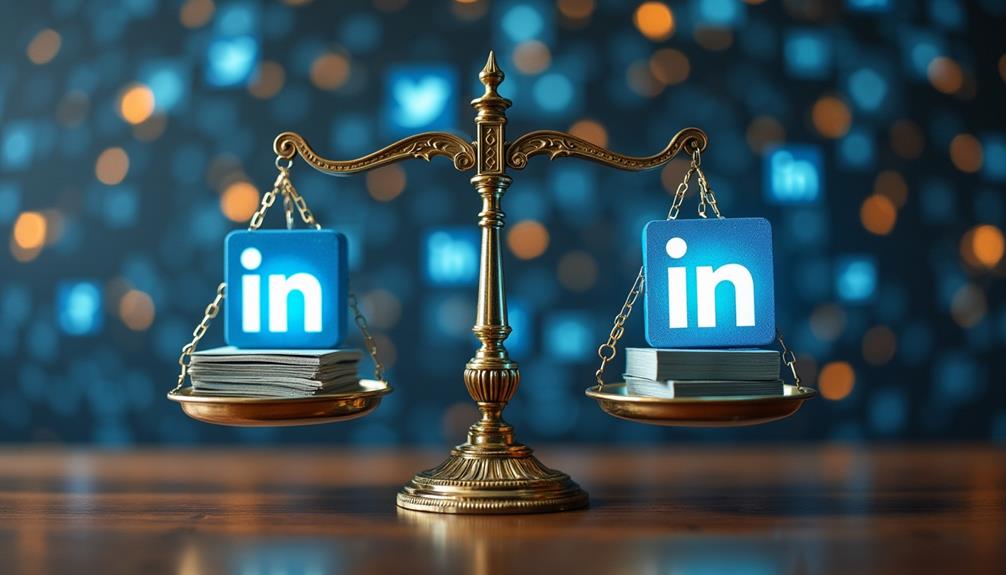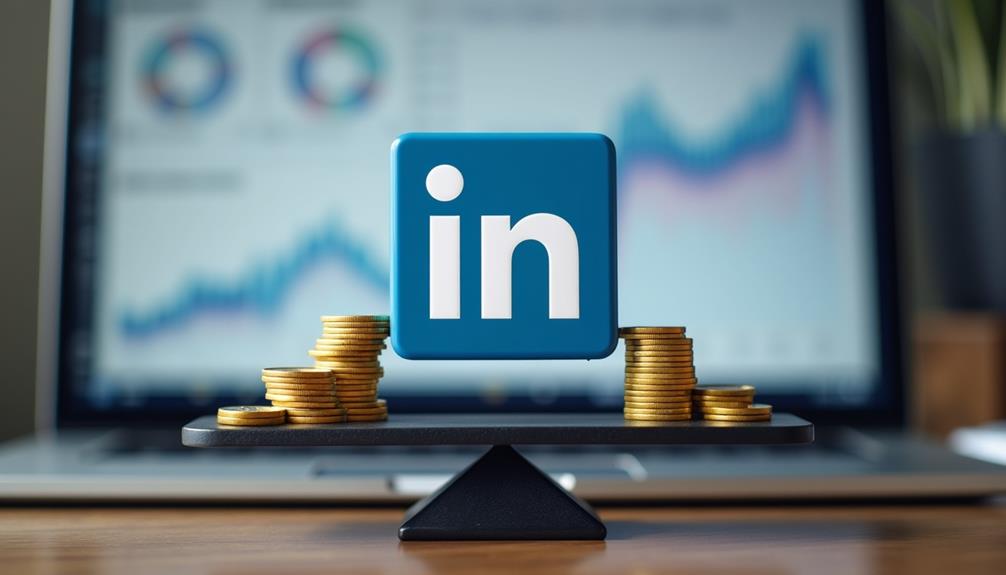
How much to charge for 50K Linkedin followers?
When you’re deciding how much to charge for 50K LinkedIn followers, you need to factor in engagement rates, follower demographics, and industry relevance. Are your followers actively engaging with your content, or are they just passive numbers? High engagement can greatly enhance your brand’s influence. Furthermore, the industry you’re in and the authenticity of your followers play essential roles in determining the price. With typical rates ranging from $1,000 to $5,000, how do you guarantee your pricing aligns with market expectations while demonstrating the potential for increased sales leads? Let’s explore these elements further.
Key Takeaways
- Assess engagement rates, aiming for 1-2%, to determine follower quality and justify higher pricing.
- Consider follower demographics, including age, industry, and job titles, to enhance content relevance and pricing.
- Analyze industry relevance, ensuring followers align with niche markets to command premium fees.
- Compare competitor pricing for similar follower counts to establish a competitive yet profitable rate.
- Highlight your unique value proposition and follower engagement metrics to support premium pricing.
Understanding Follower Value

In today’s digital landscape, understanding the value of a LinkedIn follower is akin to evaluating the worth of a strategic business asset. You can’t just count followers; you need to assess follower quality. High-quality followers are professionals who engage with your content, amplify your brand influence, and potentially convert into clients or partners.
Studies show that LinkedIn accounts with a high percentage of active, relevant followers enjoy a significant boost in brand influence. For instance, a report by LinkedIn found that companies with a strong follower base were 57% more likely to experience increased sales leads. This is because high-quality followers tend to share your posts, comment on your updates, and provide valuable feedback, thereby expanding your network reach.
Moreover, in a data-driven world, it’s essential to analyze metrics such as follower demographics, industry relevance, and engagement levels. These factors collectively determine the true value of your LinkedIn followers.
Evaluating Engagement Rates
Evaluating engagement rates isn’t just about counting likes and shares; it’s about understanding the depth of interaction your content generates. Engagement metrics like comments, shares, and click-through rates provide a clearer picture of how your audience connects with your content. A robust content strategy revolves around these metrics, guiding you to refine and optimize your posts for maximum impact.
Look at the percentage of your followers who actively engage with your posts. High engagement rates indicate that your content resonates with your audience, driving meaningful conversations and actions. For LinkedIn, aim for engagement rates between 1-2%. Anything above that signals exceptional performance.
Track metrics like the number of comments per post and the quality of those interactions. Are your followers asking questions, providing insights, or simply dropping quick reactions? Detailed comments suggest a deeper level of engagement and interest.
Also, analyze the share rate. When followers share your content, they amplify your reach and credibility, essential for thought leadership.
Incorporating these engagement metrics into your content strategy helps you understand what works and what doesn’t, ensuring you continually innovate and adapt to audience preferences. This data-driven approach is vital for setting a fair price for your LinkedIn follower base.
Analyzing Industry Relevance

When determining how much to charge for LinkedIn followers, it’s vital to analyze industry relevance. You need to understand how follower authenticity and niche alignment impact your value proposition.
Authentic followers, those genuinely interested in your industry, enhance your credibility and influence. This authenticity is significant because it directly affects engagement rates and conversion potential.
Niche alignment is another important factor. If your followers are tightly aligned with your industry, it means they’re more likely to engage with your content and be interested in your offerings. For instance, a tech startup with 50K followers interested in technology trends will be more valuable than a generic profile with the same follower count.
Data shows that industry-specific influencers can command higher fees due to their specialized audience. According to recent trends, businesses are increasingly willing to pay a premium for followers that match their target market.
Considering Follower Demographics
Understanding industry relevance sets the stage for another significant aspect: follower demographics. You can’t overlook the importance of knowing who your followers are when determining the value of your 50K LinkedIn followers. It’s not just about the numbers; it’s about the quality of those numbers and how they align with the target audience’s interests and needs.
Analyzing follower demographics helps you assess the potential engagement and conversion rates. Here’s a simplified breakdown:
| Demographic Aspect | Key Insights |
|---|---|
| Age Range | Are your followers mostly millennials, Gen X, or baby boomers? Each group has different preferences and spending habits. |
| Industry | Do your followers primarily belong to tech, finance, healthcare, or another sector? This affects how you position your offering. |
| Job Titles | Are they entry-level, mid-management, or C-suite executives? Understanding this helps tailor your content and pitch. |
| Geographic Location | Where are your followers based? This can impact the relevance of your content and the likelihood of engagement. |
Diving into these metrics provides a clearer picture of your network’s value. When your follower demographics align well with your target audience, you can command a higher price, as the potential for engagement and ROI skyrockets. Focus on follower interests to guarantee your audience is as impactful as possible.
Setting Your Price

With a solid grasp of your follower demographics, the next step is setting your price. To develop effective pricing strategies, start by examining industry benchmarks. Look at what competitors are charging for similar follower counts. Conduct a thorough competitor analysis to identify the price range for 50K LinkedIn followers within your niche. This will help you position your offer competitively.
You should also consider your unique value proposition. If your followers are highly engaged or segmented into a desirable industry, you can justify a higher price. Use data analytics to showcase follower engagement metrics such as likes, shares, and comments. This data-driven approach makes your offering more attractive to potential buyers.
Another angle is to stay trend-aware. Monitor how pricing strategies evolve in real-time. Platforms like LinkedIn often see price fluctuations based on the demand for specific niches. By staying current, you can adjust your pricing to maximize profitability.
Lastly, be transparent about what clients will gain. Highlight the advantages of tapping into your 50K followers. This audience-focused strategy will build trust and justify your premium pricing.

